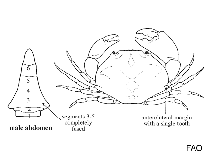Carpilius corallinus (Herbst, 1783)
Batwing coral crab| Native range | All suitable habitat | Point map | Year 2050 |

|
| This map was computer-generated and has not yet been reviewed. |
| Carpilius corallinus AquaMaps Data sources: GBIF OBIS |
Upload your photos
Google image | No image available for this species;
drawing shows typical species in Carpiliidae.
Google image | No image available for this species;
drawing shows typical species in Carpiliidae.
Classification / Names Common names | Synonyms | CoL | ITIS | WoRMS
Malacostraca | Decapoda | Carpiliidae
Environment: milieu / climate zone / depth range / distribution range Ecology
Benthic; depth range 1 - 50 m (Ref. 101362), usually 1 - 20 m (Ref. 116371). Tropical; 33°N - 25°S, 98°W - 34°W
Distribution Countries | FAO areas | Ecosystems | Occurrences | Introductions
Western Atlantic: From Florida, the Gulf of Mexico and Antilles to Venezuela and Brazil. Tropical to subtropical.
Length at first maturity / Size / Weight / Age
Maturity: Lm ? range ? - ? cm Max length : 15.0 cm CW male/unsexed; (Ref. 101376)
Minimum depth range from Ref. 101314. In shallow waters. Inhabits rocks, coral reefs (Ref. 101314), rubble (Ref. 97531). Nocturnal (Ref. 101376). Feeds on mollusks and crustaceans (Ref. 112911).
Life cycle and mating behavior Maturity | Reproduction | Spawning | Eggs | Fecundity | Larvae
Mating: The male initiates mating by displaying an upsidedown position, waving its chelae and legs, to attract the female. Afterwards, the female crawles on top of the male. The male cradles the female with its legs. The couple then turns over, the male assumes the superior position and the female the lower, inverted position. The female has its telson opened, curved over that of the male and barely reaching the posterior margin of the male's carapace. Coupling lasts for 2 days, the male dies afterwards.
Main reference
References | Coordinator | Collaborators
Laughlin, R.A. 1982. (Ref. 101362)
IUCN Red List Status (Ref. 130435)
CITES status (Ref. 108899)
Not Evaluated
CMS (Ref. 116361)
Not Evaluated
Threat to humans
Human uses
Fisheries: commercial
| FishSource | Sea Around Us
Tools
More information
Age/Size
Growth
Length-weight
Length-length
Morphology
Larvae
Abundance
Growth
Length-weight
Length-length
Morphology
Larvae
Abundance
Internet sources
BHL | BOLD Systems | CISTI | DiscoverLife | FAO(Publication : search) | Fishipedia | GenBank (genome, nucleotide) | GloBI | Gomexsi | Google Books | Google Scholar | Google | PubMed | Tree of Life | Wikipedia (Go, Search) | Zoological Record
Estimates based on models
Preferred temperature
(Ref. 115969): 25.4 - 28, mean 27.3 (based on 144 cells).
Price category
(Ref. 80766):
Unknown.
Nutrients: Calcium = 109 [35, 184] mg/100g; Iron = 1.59 [1.21, 1.97] mg/100g; Protein = 20.2 [19.2, 21.3] %; Omega3 = 0.285 [0.185, 0.386] g/100g; Selenium = 48.3 [-31.7, 128.3] μg/100g; VitaminA = 0 μg/100g; Zinc = 1.79 [1.17, 2.40] mg/100g (wet weight).



